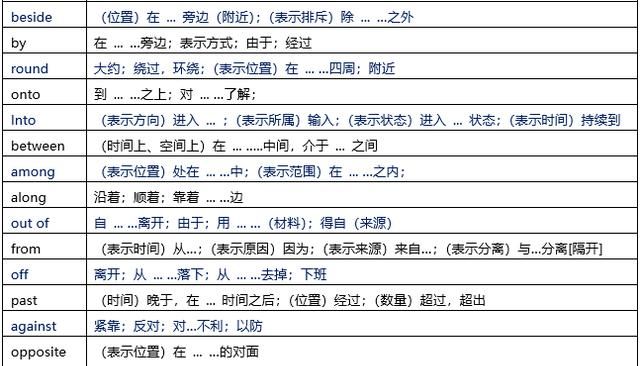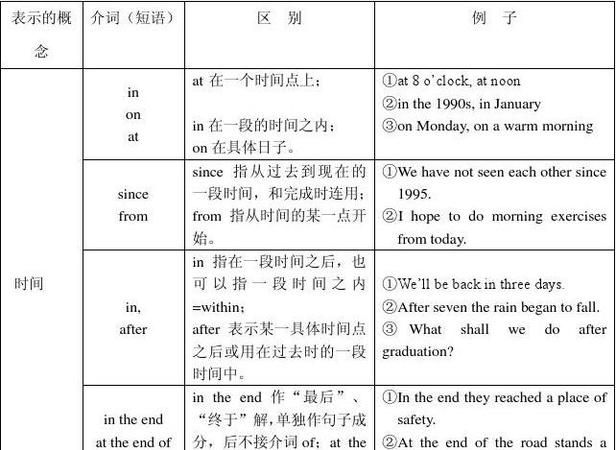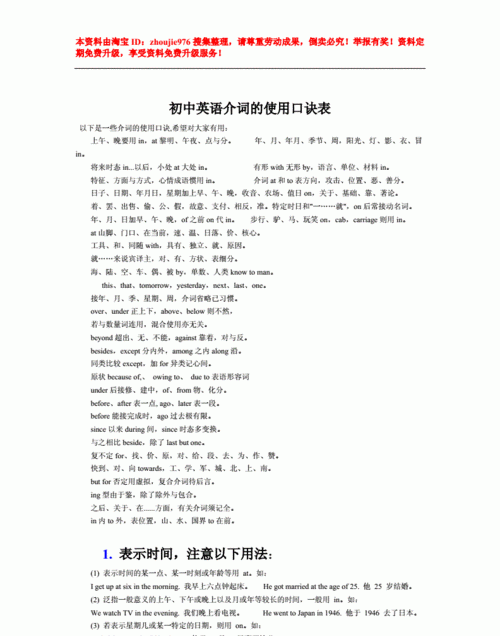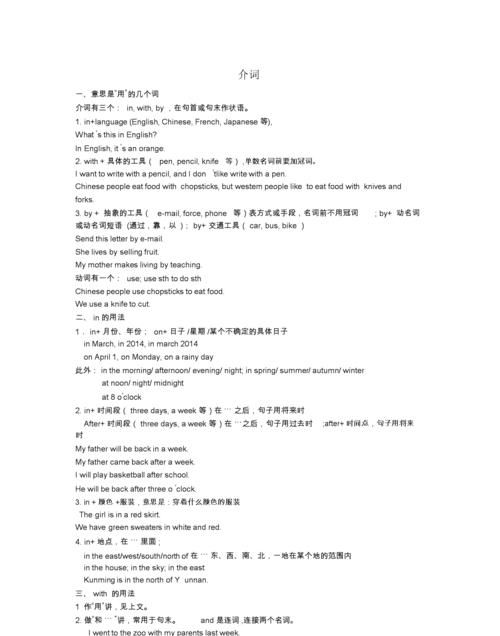本文目录
初中英语常见的介词
表方位的有:at
,in,
on,
to(大多数情况是做不定式后街动词原形,作介词时,意思是到……地方去),for,above,
over,
on,below,
under,
in
front
of,
in
the
front
of,beside,behind
表示时间的有:in
,
on,at,
in,
after
,from,
since,
after,
behind
表示运动方向的across,
through
表示“在……之间”的between两者,
among三者或三者以上
表示其他意义的on
,about
关于
by,
with,
in
表示方法、手段、工具
except不包括,
besides(包括)
除了
介词后面跟动词时一定跟ing形式,介词后面也可以加名词或从句

初中英语方位介词有哪些
⑴ 时间或地点介词in、on、at的用法区别:表示时间时, in表示在一段时间里(在将来时句子中则表示在一段时间之后), on表示在具体的某一天或者某天的上下午等, at表示在某个时刻或者瞬间;表示地点时, in表示在某个范围之内, on表示在某个平面上或与一个面相接触,at则表示在某个具体的场所或地点。如:He was born on the morning of May 10th.(他出生于五月十日的早晨)/ I usually get up at 7:00 in the morning.(我通常在早上的七点钟起床) / His glasses are right on his nose.(他的眼镜就架在他的鼻子上)/ He is at the cinema at the moment.(此刻他正在电影院)
⑵ after与in表示时间的用法区别:“after+(具体时刻/从句)”表示“在…时刻之后”常用于一般时态;“in+(一段时间)”表示“在(多久) 之后”,常用于将来时态。如:He said that he would be here after 6:00.(他说他六点钟之后会来这儿)/ My father is coming back from England in about a month.(我父亲大约一个月以后从英国回来)
⑶ since与for表示时间的用法区别:“since+(具体时刻/that-从句)”表示“自从…起一直到现在”,“for +(一段斶间)”表示“总共有…之久”,都常用于完成时态;如:Uncle Li has worked in this factory since 1970.(李叔叔自从1970年起就在这家工厂工作了)/ Uncle Li has worked in this factory for over 30 years. (李叔叔在这家工厂已经工作了30多年)
⑷ by、in与with表示方式的用法区别:都可以表示“工具、手段”,但是by主要表示“乘坐”某个交通工具或“以……方式”,在被动句中可以表示动作的执行者;in表示“使用”某种语言/文字,with表示“使用”某个具体的工具、手段。如:We see with our eyes and walk with our feet.(我们用眼睛看东西,用双脚走路)/ Please write that article(文章) in English.(请你用英语写那篇文章)/ Let’s go to the zoo by taxi.(我们打的去动物园吧。)/ It was written by Lao She.(那是老舍写的)
⑸ about与on的用法区别:都可以表示“有关…”,但是about的意义比较广,而on主要表示“有关…(专题/课程)”。如:Tom is going to give a talk on the history of America.(汤姆要作一个美国历史的报告)/ They are very excited talking about the coming field trip.(他们兴致勃勃地谈论着即将来到的野外旅游)
⑹ through与across、over的用法区别: through指“穿过…(门洞/人群/树林)”; across和over可以指“跨越…(街道/河流)”,可互换,但是表示“翻过…”时只能用over. 如:Just then a rat (鼠)ran across the road.(就在那时一只老鼠跑过路面)/ There is a bridge across/over the river.(河上有座桥)/ They climbed over the mountain and arrived there ahead of time.(他们翻过大山提前到达了那里)/ The visitors went through a big gate into another park.(参观者们穿过一个大门来到另一个公园)
(7)as与like的区别:两个词都表示“像……”,但是as译为“作为……”,表示的是职业、职务、作用等事实,而like译为“像……一样 ”,表示外表,不是事实。如:Let me speak to you as a father.(我以父亲的身份和你讲话。)(说话者是听者的父亲) / Let me speak to you like a father.(让我像一位父亲一样和你讲话)(说话者不是听者的父亲)
(8)at the end of、by the end of、to the end、in the end的用法区别:at the end of…既可以表示时间也可以表示地点,译为“在…末;在…尽头”,常与过去时连用;by the end of…只能表示时间,译为“在…前;到…为止”,常用于过去完成时; in the end与at last基本等义,表示“终于、最后”,通常用于过去时;to the end译为“到…的终点为止”,前面往往有表示运动或连续性的动词。如:By the end of last term we had learned 16 units of Book III.(到上学期期末我们已经学习了第三册16个单元)/ At the end of the road you can find a big white house with brown windows.(在路的尽头你能找到一幢有棕色窗户的白房子)/ They left for Beijing at the end of last week.(上周末他们动身去了北京)/ In the end he succeeded in the final exams.(他最终在期末考试中考及格了)/ We should go on with the work to the end.(我们应该把工作干到底)/ Follow this road to the end and you will see a post office.(沿这条路走到底就能看见一家邮电局)
(9)for a moment、for the moment、in a moment、at the moment的区别:for a moment“一会儿、片刻”(=for a while),常与持续性动词连用;for the moment“暂时、目前”,常用于现在时;in a moment“一会儿、立即、马上”(=soon; in a few minutes),一般用于将来时;at the moment“此刻,眼下”(=now),用于现在进行时。如:Please wait for a moment.(请稍等)/ Let’s leave things as they are for the moment.(暂时就维持现状吧!) / I’ll come back in a moment.(我过会儿回来)/ I am very busy at the moment.(眼下我很忙)
(10)but的问题:用介词but引出另一个动词时,要注意:如果前面有do,后面就用原形动词,前面没有do时,后面的动词要加to。如:I could do nothing but wait.(我什么也做不了只能等) / They had no choice(选择) but to fight.(他们没有选择只有战斗)
(11)in front of 与in the front of: in front of“在…的前面”, 与in the front of“在…的前部”。如:A car was parking in front of the hall.(大厅跟前停着一辆汽车)/ In the front of the hall stood a big desk.(大厅前部立着一个大讲台)
(12)except (for)与besides的区别:except“除了”,表示排除掉某人物,即不包含;而besides“除了”则表示包含,即“不仅……又……”。如:Everyone went to the Palace Museum except Tom.(除了Tom,大家都去了故宫博物院)(Tom没有去故宫)/ Besides Chinese he also studied many other subjects.(除了汉语之外,他还学其他许多功课)(“汉语”也是他学的功课之一)
other than 除了......之外...... There 're nobody here other than me 与.....不同..... 与.....不同方式.....we can't get there other than by swimming.
Apart from : with the exception of ...; besides... Apart form a few scratches, the car was undamaged.

初中的英语中常用的介词有哪些?
英语中最常用的介词,按照不同的分类标准可分为以下几类:
(1). 简单介词、复合介词和短语介词
①.简单介词是指单一介词。如:
at , in ,of ,by , about , for, from , except , since, near, with 等。
②. 复合介词是指由两个简单介词组成的介词。如:
Inside, outside , onto, into , throughout, without , as to as for , unpon, except for 等。
③. 短语介词是指由短语构成的介词。如:
In front of , by means o f, on behalf of, in spite of , by way of , in favor of , in regard to 等。
(2). 按词义分类
{1} 表地点(包括动向)的介词。如:
About ,above, across, after, along , among, around , at, before, behind, below, beneath, beside, between , beyond ,by, down, from, in, into , near, off, on, over, through, throught, to, towards,, under, up, unpon, with, within , without 等。
{2} 表时间的介词。如:
About, after, around , as , at, before , behind , between , by, during, for, from, in, into, of, on, over, past, since, through, throughout, till(until) , to, towards , within 等。
{3} 表除去的介词。如:
beside , but, except等。
{4} 表比较的介词。如:
As, like, above, over等。
{5} 表反对的介词。如:
againt ,with 等。
{6} 表原因、目的的介词。如:
for, with, from 等。
{7} 表结果的介词。如:
to, with , without 等。
{8} 表手段、方式的介词。如:
by, in ,with 等。
{9} 表所属的介词。如:
of , with 等。
{10} 表条件的介词。如:
on, without , considering 等。
{11} 表让步的介词。如:
despite, in spite notwithstanding等。
{12} 表关于的介词。如:
About, concerning, regarding ,with regard to, as for , as to
{13} 表对于的介词。如:
to, for over , at , with 等。
{14} 表根据的介词。如:
on, according to 等。
{15} 表其他的介词。如:
for(赞成),without(没有)等。

初中的英语中常用的介词有哪些?
一、介词按其构成可分为: 1. 简单介词 at, in, on, to, since, until等。如: He's worked there since 1998. 2. 复合介词 into, onto, out of等。如: She is out of school. 她毕业了。 3. 二重介词 from under, from behind, from out of, until after, except in等。如: I'm from out of town. 我是从城外来的。 4. 短语介词 because of, instead of, in spite of等。如: I went back not because of the rain, but because I was tired.我回去不是因为下雨,而是因为我累了。 二、介词的作用: 1. 表示地点: after, along, at, below, by, of, near, over, through, under等。如: Near the village the boys are skating on the ice. 男孩子们正在村子附近的冰上滑冰。 They lay down under the shade of a tree. 他们躺在一棵树的树阴下。 2. 表示时间: about, after, across, at, during, for, in, of, till, until等。如: After class he will tell us about the accident. 课后他将告诉我们有关事故的情况。 A heavy rain has been falling across three days. 一场大雨下了整整三天。 The accident happened during the night. 事故发生在夜间。 3. 表示动作: at, across, around, on, over, under等。如: The earth goes around the sun. 地球绕太阳运行。 The car is under repair. 汽车在修理中。 4. 表示比较: as, like, above, over, with等。如: She was something like her sister. 她有几份像她的妹妹。 Chinese is much more difficult in contrast with English. 和英语相比,汉语难得多。 5. 表示原因: about, for, from, with等。如: Don't worry about my lessons. 不要担心我的功课。 Business kept me from coming. 我因事不能来。 He was angry with what I did. 他对我所做的很气愤。 6. 表示条件: to, with, without等。如: Without your advice, he would have failed. 没有你的忠告他可能已经失败了。 7. 表示手段、方式: as, by, in, with等。如: He behaved as a drunkard. 他的举止如同醉汉一样。 Learn the new words by heart.记住这些生词。 We see with our eyes.我们用眼睛看。 8. 表示距离、数量: from, in, within等。如: My house is ten miles from the school. 我家离学校十英里。 They were thirty in all. 他们总共有三十人。 9. 表示目的: as, for等。如: I only said it as a joke. 我只是把它当作笑话讲的。 It's time for class. 到上课的时间了。 10. 表示让步: for, with等。如: For all his effort, he didn't succeed. 虽然他做了一番努力,仍不能成功。 With all his money, he is unhappy. 尽管他有钱,但他并不快乐。 for还可以引导插入语,例如: I, for one, shall vote against the proposal. 我也投票反对这个提议以上希望对你有帮助,是几乎所有介词的用法了 by的用法(1)表示在……旁,如by the fire 在炉火旁。(2)用于被动语态,表示“被”,如It is planted by Tom . (3)到……为止,在……以前,如We can get the books by Monday . (4)依照,依据,如By your theory , ……,按你的理论,……(5)表示方法,手段,by sea乘船,by bus(6)由于,因……,I”d know you by your laugh . (7)表示把,握的部位,She pulled me by the sleeve . 她抓住我的衣袖。in的用法:in是介词,介词后面必须接名词,代词或者动名词,即doing。 这是介词的一个特点,当介词in单独使用时,或者与其它动词构成固定搭配时,都不能脱离其作为介词的特点。in 常用意思:在..., 在...之内,从事于..., 按照..., 穿着...。 He was born in 1992. 他生于1992年。 I could finish the program in two weeks.我可以用两周时间完成这个项目。 He spend less time in reading.他读书时间很少。 The man in black jacket is our teacher.穿黑夹克的那个人是我们的老师。in是介词,介词后面必须接名词,代词或者动名词,即doing。 这是介词的一个特点,当介词in单独使用时,或者与其它动词构成固定搭配时,都不能脱离其作为介词的特点。in 常用意思:在..., 在...之内,从事于..., 按照..., 穿着...。 He was born in 1992. 他生于1992年。 I could finish the program in two weeks.我可以用两周时间完成这个项目。 He spend less time in reading.他读书时间很少。 The man in black jacket is our teacher.穿黑夹克的那个人是我们的老师。 一些与介词in的固定搭配 表示时间in 1999, in 20 century,表示地点in a car, in a queue, 表示状态in charge(看管), in church, in class,to的用法一:表示相对,针对 be strange (common, new, familiar) to二:表示对比,比较1:以-ior结尾的形容词,后接介词to表示比较,如:superior ,inferior,prior,senior,junior The quarrel happened prior to my arrival. 2:一些本身就含有比较或比拟意思的形容词,如equal,similar,equivalent,analogous A is similar to B in many ways. 3:表示一些先后顺序的形容词,如:second,subsequent,next,preliminary,preparatory 4:to也偶尔出现在个别动词之后,与动词形成固定词组,表示比较,如:prefer to,compare to,in contrast to compare to sth.表示比喻或比拟,而compare with sth.表示比较,如: World is usually compared to a stage

以上就是关于初中英语常用介词50个 ,初中英语常见的介词的全部内容,以及初中英语常用介词50个 的相关内容,希望能够帮到您。
